

Procurement Orchestration Guide: Benefits (+ 5 Proven Ways to Master)
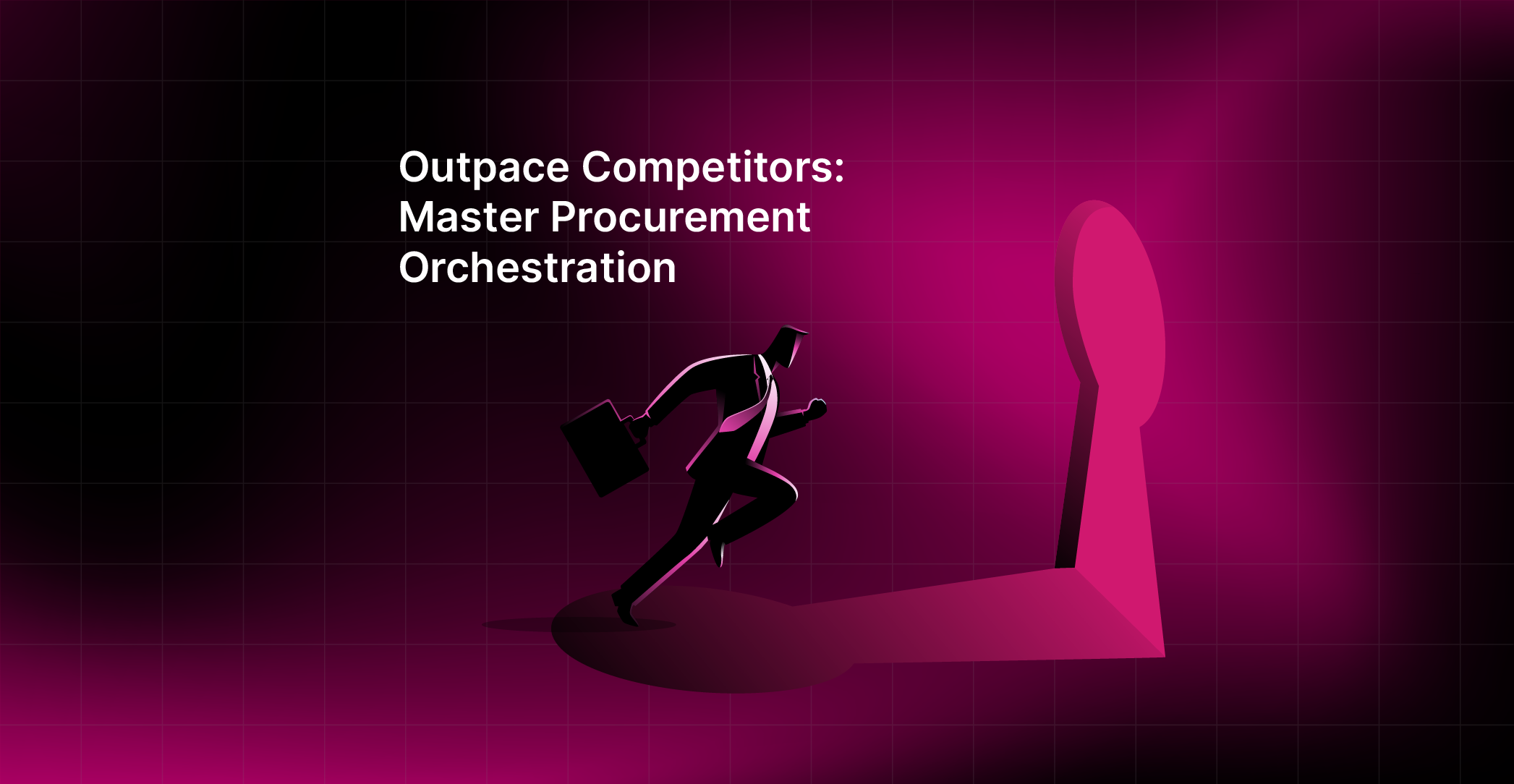
Procurement Orchestration Guide: Benefits (+ 5 Proven Ways to Master)
Learn key procurement orchestration strategies to enhance efficiency, reduce costs, and build robust supplier relationships.


Procurement is not simple. It involves countless processes that can quickly go out of hand and become too much to handle. Especially with the growing demands for efficiency, cost-effectiveness, and agility throughout the industrial sector.
The concept of procurement orchestration can be a game-changer for any organization. It transforms traditional purchasing methods into dynamic, integrated systems that drive strategic value and competitive advantage. Experts believe that the right digital transformation initiatives can be the differentiating factor for businesses, and the right procurement initiatives can allow you to maximize the benefits for your business at a minimal cost.
Procurement orchestration explained
Procurement orchestration is a strategic approach that harmonizes and integrates various processes using digital tools or platforms. It consolidates all communication, technical details, plans, and strategies into one window to better steer you in the right direction. The right orchestration approach aims to create seamless operations that not only enhance efficiency but also optimize spend while strengthening supplier relationships.
By leveraging advanced technologies and streamlined workflows, organizations can ensure that their procurement activities align with their overall business objectives. This, as a result, fosters agility and responsiveness in the face of market changes and disruptions.
Why is effective procurement orchestration important?
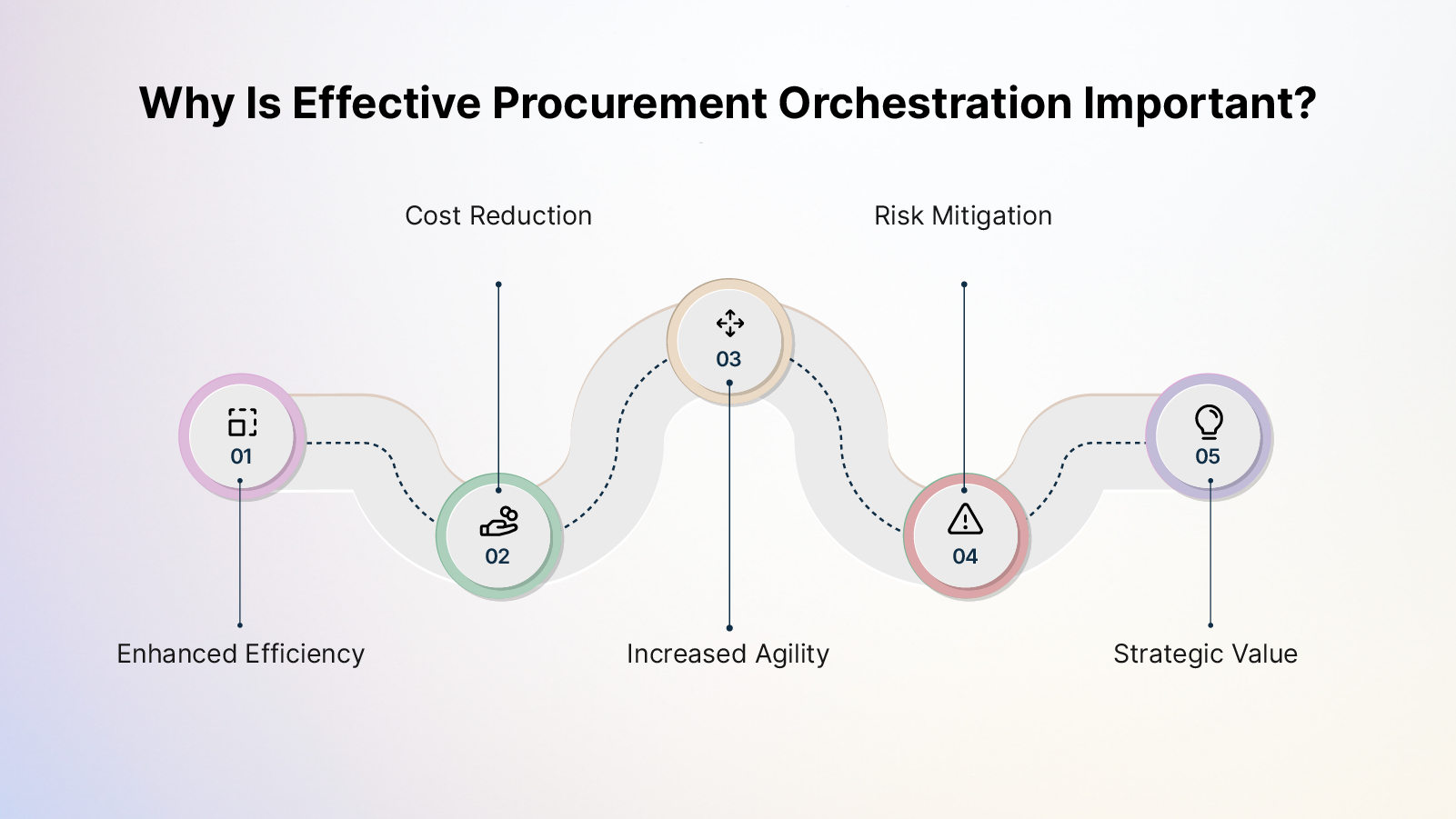
Effective procurement orchestration is crucial for several reasons:
Enhanced Efficiency
Procurement orchestration automates routine tasks and consolidates procurement data into a single, accessible platform. This allows organizations to reduce time spent on manual processes and eliminate redundancies. The streamlined approach allows procurement teams to focus on more strategic tasks, such as market analysis and relationship building.
Cost Reduction
Orchestration helps identify cost-saving opportunities by providing a holistic view of procurement spending and supplier performance. This visibility enables businesses to negotiate better terms, take advantage of volume discounts, and minimize waste.
Increased Agility
In today’s fast-paced market, agility is key. Procurement orchestration facilitates quick adaptation to new market conditions or changes in business strategy. This flexibility is essential for maintaining competitive advantage.
Risk Mitigation
With a comprehensive overview of the procurement landscape, organizations can better assess and manage risks associated with suppliers and market volatility. Effective risk management ensures continuity and reliability in adverse conditions.
Strategic Value
Beyond operational improvements, procurement orchestration enhances the strategic role of the procurement function. It enables procurement to contribute to overall business strategy through data-driven insights and proactive supplier management, which can lead to innovation and growth.
Effective procurement orchestration transforms procurement from a tactical, administrative function into a strategic asset, driving not just savings but also contributing significantly to the overall strategic objectives of an organization. By adopting a more orchestrated approach, companies can navigate the complexities of modern procurement, meet evolving demands, and position themselves strongly for future challenges and opportunities.
The main challenges
While the benefits of procurement orchestration are significant, organizations face several challenges when trying to implement it.
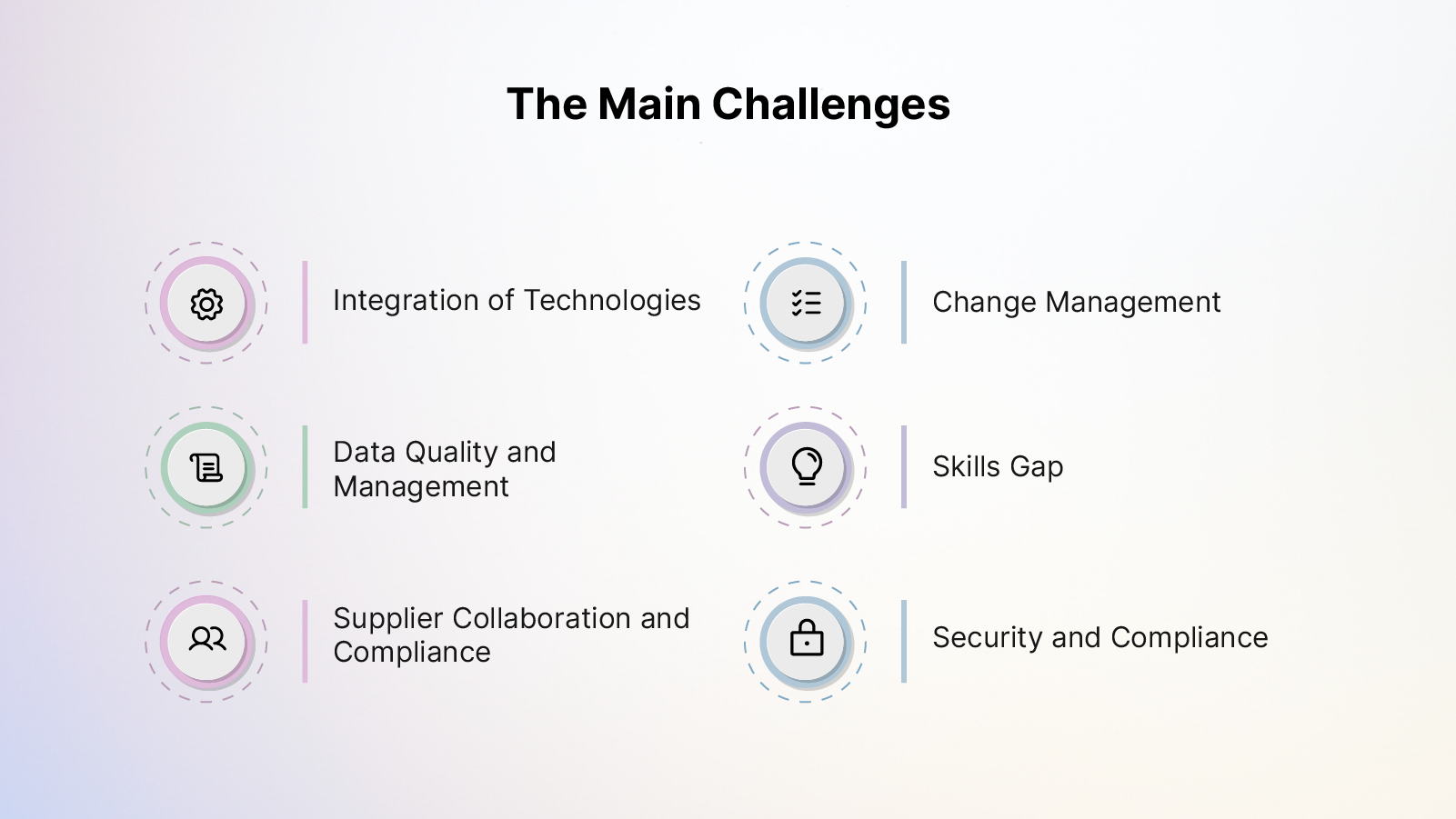
Here are some of the main hurdles businesses may encounter:
- Integration of Technologies: One of the most daunting challenges is the integration of diverse technologies. Many organizations operate on legacy systems that are not readily compatible with newer, more advanced software solutions.
- Change Management: The shift from traditional procurement methods to a fully orchestrated approach involves significant changes in processes and roles. Resistance from within the organization can be a major barrier.
- Data Quality and Management: High-quality, accessible data is the foundation of effective procurement orchestration. Organizations must ensure that their data is accurate, consistent, and comprehensive.
- Skills Gap: As procurement becomes more technologically driven, there is a growing need for skills that may not exist within the current workforce. Recruiting or training personnel with expertise in areas such as data analytics, software management, and strategic sourcing is essential but can be a lengthy and costly process.
- Supplier Collaboration and Compliance: Building and maintaining strong relationships with suppliers is crucial for successful procurement orchestration. However, ensuring that suppliers comply with new systems and processes can be challenging, especially when dealing with a diverse supplier base with varying capabilities.
- Security and Compliance: As procurement systems become more integrated and reliant on digital processes, the risk of cyber threats increases. Ensuring the security of procurement data and systems is paramount.
5 Ways to Excel at Procurement Orchestration
To truly excel at procurement orchestration, organizations must adopt a multifaceted approach that addresses various operational and strategic aspects of procurement. Here are five effective ways to enhance procurement orchestration within your business:
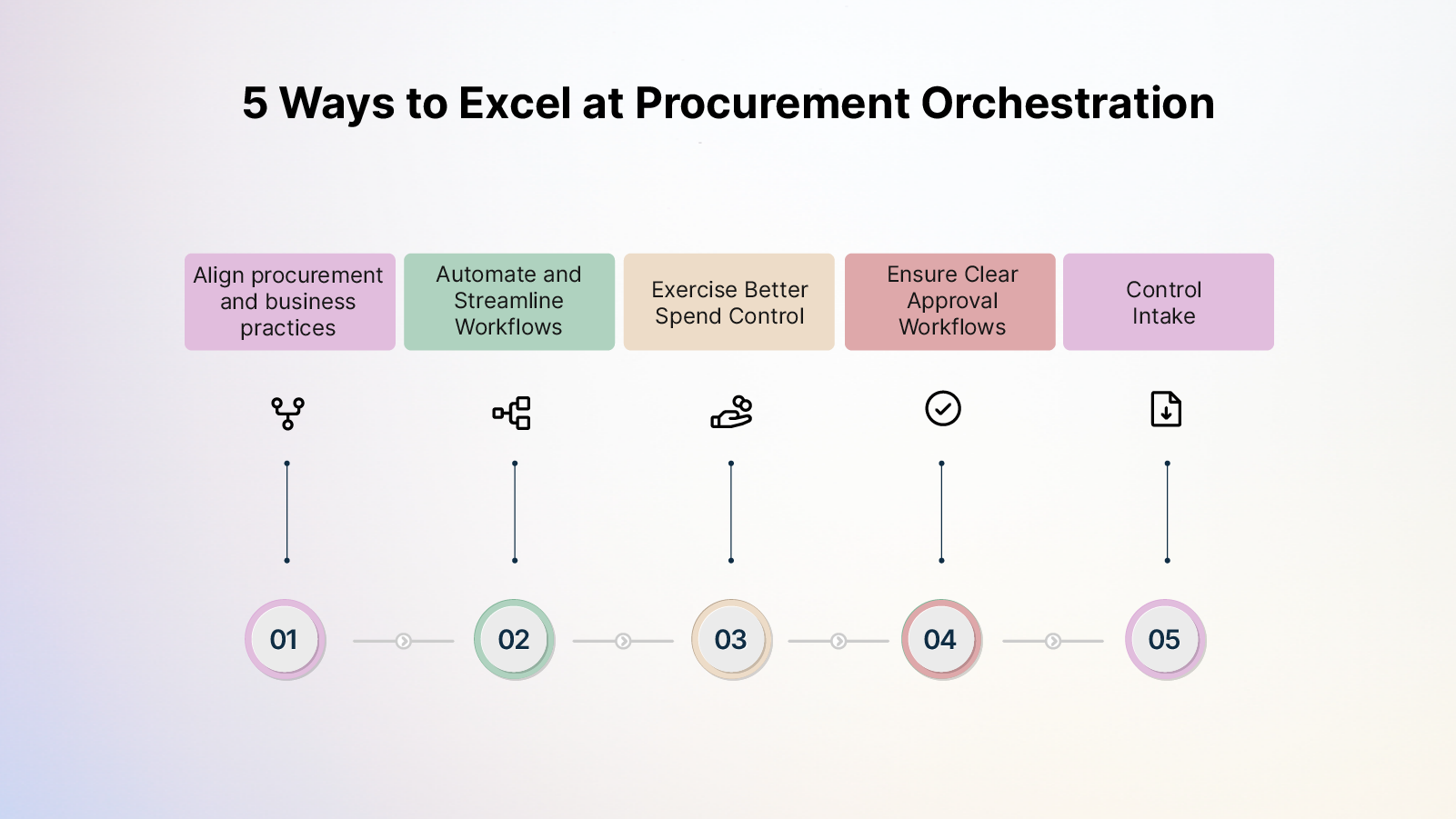
1. Align procurement and business practices
Alignment between procurement strategies and overall business goals is crucial. Ensure that procurement policies support and are integrated with broader business objectives. This alignment helps streamline operations and makes procurement a strategic partner in achieving organizational success. Regular reviews and adjustments to procurement policies should be conducted to maintain this alignment as business strategies evolve.
2. Automate and Streamline Workflows
Leveraging automation technologies can significantly improve the efficiency and accuracy of procurement processes. Automation helps eliminate manual errors and speeds up transaction times, from requisition to purchase order and invoicing. Implement tools that automate routine procurement tasks, such as order processing and vendor comparisons, to free up your team's time for more strategic activities.
3. Exercise Better Spend Control
Implementing robust spend management practices is vital for maintaining budget discipline and enhancing financial performance. Use procurement orchestration tools to gain real-time insights into spending patterns and enforce budget compliance. Techniques like spend analysis, contract management, and supplier consolidation can provide more control and visibility over how funds are allocated and spent.
4. Ensure Clear Approval Workflows
Clear and efficient approval workflows are essential for minimizing delays and maintaining process integrity. Design workflows that are straightforward and transparent, with well-defined roles and responsibilities. Use digital tools to set up automated approvals based on specific criteria, which can help reduce bottlenecks and improve the speed of procurement operations.
5. Control Intake
Managing the intake process effectively is key to preventing process inefficiencies and ensuring that procurement requests are legitimate and necessary. Implement a centralized intake system where all procurement requests are submitted and reviewed. This system should assess the validity and urgency of each request and ensure it aligns with organizational priorities and available resources.
Best Practices for Procurement Orchestration
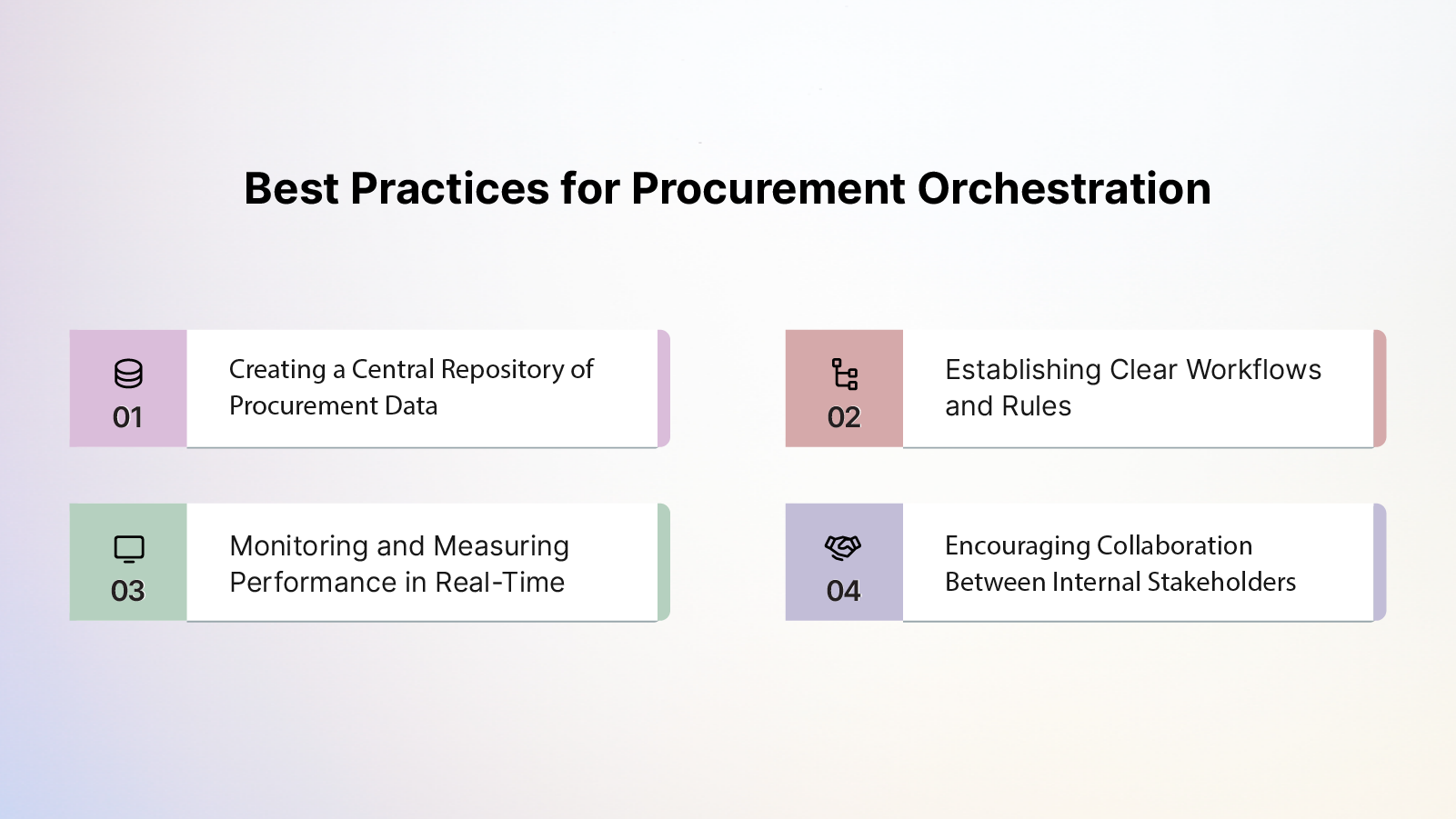
Procurement orchestration involves not just adopting new tools but also embracing a strategic framework that can drive long-term success. Here are some best practices that can help any organization excel in its procurement orchestration efforts:
- Creating a Central Repository of Procurement Data: Data is a critical asset in effective procurement orchestration. Establish a centralized data repository that collects and stores all procurement-related information.
- Establishing Clear Workflows and Rules: Define clear and concise procurement workflows that outline each step of the procurement process, from requisition to payment. These workflows should include specific rules regarding who can make requests, approve purchases, and handle supplier negotiations. Well-defined workflows prevent confusion, reduce errors, and enhance the speed of procurement operations.
- Monitoring and Measuring Performance in Real-Time: Implement systems that allow for the real-time monitoring and analysis of procurement activities. This enables the immediate identification and resolution of issues, adjustments in strategies based on performance data, and the optimization of procurement processes.
- Encouraging Collaboration Between Internal Stakeholders: Foster an environment where collaboration is valued and facilitated. Encourage regular communication between procurement staff, end-users, and key approvers within the organization. This collaboration ensures that procurement decisions are well-informed and reflect the needs and insights of various parts of the organization.
How Spendflo could be the right partner for your procurement initiatives
Effective procurement orchestration demands streamlined workflow, effective monitoring, greater spend control, and a lot more. Spendflo provides an effective suite of tools and functionalities designed to enhance how companies handle their software subscriptions. Here’s a closer look at how Spendflo can assist organizations:
- Streamlining Approval Workflows: Spendflo simplifies the approval process for SaaS purchases and renewals by automating workflows. By setting predefined approval rules based on expenditure thresholds, departmental needs, or vendor criteria, Spendflo ensures that all SaaS acquisitions go through the necessary checks efficiently. This minimizes delays and enhances compliance, as only authorized personnel can approve expenses, and all actions are logged for audit purposes.
- Monitoring Expenses in Real-Time: Spendflo offers a centralized dashboard that provides a comprehensive view of an organization's SaaS expenses. This real-time visibility allows finance teams to track ongoing expenses against their budgets. The platform’s analytics capabilities enable the identification of trends and anomalies, which can prompt timely interventions to avoid budget overruns and ensure financial discipline.
- Exercising Greater Spend Control: Through consolidated management of SaaS subscriptions, Spendflo helps businesses avoid unnecessary renewals and redundant software. The platform offers tools for rigorous spend analysis, which assists in identifying underutilized or unneeded subscriptions that can be eliminated or renegotiated.
- Optimizing SaaS Procurement: Spendflo not only manages existing subscriptions but also assists in the procurement of new software. By providing market insights and vendor comparisons, it helps businesses make informed decisions that align with their operational needs and budget constraints. This strategic approach ensures that organizations get the best value from their SaaS investments.
- Ensuring Compliance and Governance: The platform supports compliance with internal policies and external regulations by ensuring that all SaaS procurements and renewals are consistent with established guidelines. Spendflo’s robust documentation capabilities also help in maintaining an audit-ready posture with detailed records of all transactions, approvals, and interactions with vendors.
Key Takeaways
Procurement orchestration is a transformative strategy that enhances efficiency, reduces costs, and aligns procurement processes with broader business goals. Effective implementation, however, requires overcoming significant challenges such as technology integration, change management, and data handling.
Tools like Spendflo offer an excellent solution by simplifying the complexities associated with SaaS procurement. Its key features allow you to streamline approval workflows, monitor expenses in real time, and exercise greater spend control.
Spendflo is a crucial partner for companies looking to optimize their software investments. The platform's ability to automate processes, provide actionable insights, and ensure compliance makes it an invaluable asset for businesses aiming to thrive in a digital-first economy.
Effective SaaS procurement is only a few clicks away. Get in touch with a Spendflo expert to get started.















.png)










.avif)





